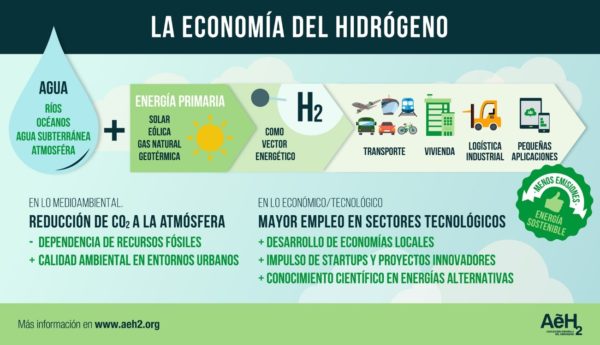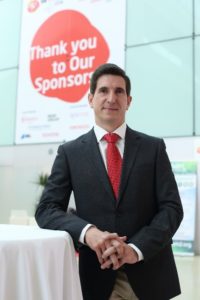admin | 28/05/2019
Hydrogen is the most abundant element in the universe, however, the free element is rarely found on Earth as it must be extracted from other materials such as water, carbon, biomass, and natural gas. This availability, along with the element’s high efficiency, low toxicity, long life, and cleanliness, make this resource highly valued by the scientific and industrial community, since, despite being a very light gas, it contains a large amount of energy.
It is therefore not a source of energy itself, but rather an energy carrier. “It is an energy carrier that allows large amounts of energy from any source to be stored inside it,” stated Javier Brey, president of AeH2 (Spanish Hydrogen Association).
The two most well-known and well-developed production methods are:
– Steam reforming from natural gas: entails 95% of current global production. This consists of combining methane (main component of natural gas) with steam to produce carbon dioxide (CO2) and hydrogen. A great disadvantage of this process is that it intrinsically produces polluting emissions (CO2) and uses a fossil fuel (natural gas) as the raw material.
– Electrolysis of water: this method currently only provides 5% of hydrogen production. It is done by decomposing water molecules into their components (hydrogen and oxygen) with electricity. The objective is to generate renewable electricity (not necessarily surplus energy) in order to reduce costs and obtain hydrogen without the emissions associated with its production. This is something that is already occurring in Asia and MENA (Middle East and North Africa), where renewable energy costs 2.5 cents per kWh, and therefore, according to AeH2, the hydrogen from electrolysis is able to compete with the price of hydrogen from natural gas reforming.
Hydrogen is the cleanest fuel in existence, with a great capacity for energy storage and the possibility of coming from several energy sources
Great potential
Hydrogen can be recombined with oxygen from the air in an electrochemical device called a ‘fuel cell’, which allows electricity and water to be obtained as the only emissions. This is a system for which new uses have been being developed for decades. The element can also be used as a raw material for a number of chemical processes and burned to obtain heat for certain applications or for heating.
Moreover, its use in a fuel cell fully eliminates polluting emissions at the point where the energy is consumed. This circumstance makes hydrogen the cleanest fuel in existence.
According to Brey, its sustainability is not the only positive aspect of this energy carrier. Its low density and high volatility make it a safe material, as when it is released and dispersed it does not pollute the environment or affect people’s heath (it does not even cause noise pollution, as when it is used as a fuel it is practically silent).

Therefore, hydrogen may be obtained from multiple energy sources, which facilitates local and renewable use. Nevertheless, its production creates electricity, heat, and other materials or synthetic fuels, making it “a highly versatile fuel able to cover multiple needs” in several sectors.
It may also become an energy storage or management system, as it can be produced when there is surplus electricity, and stored to be produced again when required.
Industrial applications
According to the English consulting firm McKinsey, hydrogen will account for one-fifth of all energy consumed in 2050. Today, it plays a deciding role in numerous industries such as petrochemicals, which uses it to manufacture ammonia to make fertilizers, in oil refining processes, and in the hydrogenation of fats and oils, hydroalkylation, and methanol production. It also has applications in the aerospace field where it acts as an important fuel for rockets, including those that put satellites into orbit.
The president of AeH2 underscored that the hydrogen produced with electrolysis, the most sustainable process, may also contribute to the decarbonization of four large sectors:
– Energy. Hydrogen’s capacity to store energy on a large scale is especially useful for achieving greater penetration in the renewable energy market, within the electricity mix.
– Transport. Electric vehicles with fuel cells supplement those with batteries. They expand the electric mobility market with greater autonomy for continued use, where batteries are currently limited: trucks, trains, buses, boats, forklifts, etc. By 2030, hydrogen is expected to be able to power between 10 and 15 million cars and half a million trucks.
– Industry. Large amounts of hydrogen are used in several industrial sectors, but they are obtained from fossil fuels, so substituting them for “green hydrogen” would entail a huge reduction in the CO2 emissions associated with those processes.
– Residential: Injecting hydrogen into the natural gas network reduces consumption of this fossil fuel when it is used in individual buildings, offices, and companies.
Institutional support
Although hydrogen is now in a commercialization phase and available for industrial use, research is currently focused on aspects related to technology, large-scale production, increased autonomy of vehicles with fuel cells, and improved capacity of storage systems.

The main challenge with all of this is that it is a technology that is not very far reaching, which increases the cost of application. Brey is therefore in favor of public investment in pilot projects that would allow development to continue. “The countries that receive a great deal of support from the government have been able to make advances in this technology and implement it quickly, thanks to the scalability of the processes and regulatory measures that allow for more streamlined installation procedures,” he explained.
For example, countries like the United States, Japan, Germany, and Canada fund these projects and have a notable hydrogen market. For its part, Spain has a great deal of renewable potential as well as companies specializing in these innovations, allowing it to become an exporter of its own renewable hydrogen and the associated technology, where companies that install service stations are notable for transporting this gas or producing it.
Spain still has a way to go in order to achieve its great potential in this regard. That is why Javier Brey advocates for implementing the appropriate measures to encourage the development of this energy such as establishing a regulatory framework that incentivizes these technologies and facilitates their implementation, the creation of public/private consortiums, and an increase in R&D investment. “It is time to encourage the development of a solid business network within the sector that allows for thousands of new jobs to be created, know-how and patents to be generated, and huge benefits for the Spanish economy and the country’s energy security,” the expert highlighted.
Support from European community institutions will be crucial to achieving this goal. Nevertheless, employment within the sector in the European Union is expected to grow by around 5.4 million by 2050, according to the Hydrogen Roadmap Europe. In Spain alone, 227,000 jobs may be directly created by 2030 if incentivizing measures are adopted.
Relationships between the different bodies that promote international collaboration will be essential to carrying out transnational projects within the realm of hydrogen and fuel cells. With AeH2, outside Spain, the notable projects have been carried out by Fuel Cell and Hydrogen Joint Undertaking, European Hydrogen Association, International Association for Hydrogen Energy, and Hydrogen Europe, the leading European association in the sector which represents more than 100 companies working to convert hydrogen energy into an everyday reality.
Hydrogen is now available for industrial use and research is currently focused on lowering costs, developing technology, and improving storage capacity.


This article was written with assistance from…
Javier Brey studied an undergraduate degree in Telecommunications Engineering from the University of Seville and a PhD from Universidad Pablo de Olavide (Seville). His doctoral thesis was on the hydrogen economy.
In 1998, he joined the Abengoa team, where he began to work on R&D projects related to hydrogen and fuel cells. In 2013, he was appointed CEO of Abengoa Hidrógeno, the business unit that works with this material.
In 2016, he left Abengoa to create and direct H2B2, a tech company focused on clean hydrogen production through polymer electrolysis. The company currently has leading technology and is active in Europe and the US.
He is the president of AeH2 (Spanish Hydrogen Association), vice president of the EHA (European Hydrogen Association), vice president of the APPICE (Spanish Association of Fuel Cells), and secretary of PTE HPC (Spanish Technology Platform for Hydrogen and Fuel Cells).
He has actively participated on Technical Standardization Committees for UNE (Spanish Association for Standardization) both on hydrogen as a fuel and on fuel cells, representing Spain in the corresponding international committees.
He spends a portion of his time teaching as an associate professor at Loyola University Andalusia, where he teaches students about the advantages of the hydrogen economy.





